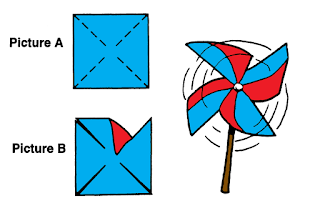This hands-on pinwheel craft is a great summertime activity! For one, you’ll be inside and out of the heat. Two, you can make it thematic for the Forth of July. And three, your kiddos will be working on reading and following instructions–skills that they can take with them into the next school year and the real world.
The below craft for making a pinwheel is from our popular, Understanding Instructions: Arts & Crafts activity book. This hands-on craft has six simple steps. Set up your craft corner with all the necessary items (plus a few extras—students will have to follow each step to get the craft just right) and print the instructions <free download>.
What You’ll Need:
– Scissors
– Ruler
– Pushpin
– Wooden Stick (chop sticks, for example)
– 6″ square paper
Tip: Get seasonally appropriate paper like American flag paper for Independence Day or have students draw and color a white piece of paper.
– Glue and Glitter (optional)
What to Do:
1. Use a ruler to draw dotted lines from each corner of the paper as shown in Picture A.
2. Cut along the dotted lines. Don’t cut all the way through to the center of the square.
3. Bend, don’t fold, one corner of each triangle into the center of the square as shown in
Picture B.
4. Attach the pinwheel to the stick with a pushpin. (If using chop stick, push the pushpin into the top, thickest part of the chop stick.)
5. Do not push the pushpin all the way in. Leave room for the pinwheel to spin.
6. Use small amounts of glue to decorate the pinwheel with glitter (optional).
Now, while the glue and decorations are drying, ask your kiddos a few comprehension questions.
Like these:
- What was the first step?
- Which of the items from the craft table did you use?
- How many cuts did you make into the paper?
- Where did you put the pushpin?
- How were you instructed to fold the paper?
- Why do you think this was an important step?
- What was the last step?
You can also have students complete this worksheet <free download> to further help them pay attention to details, find facts, and draw conclusions. The activities asks students to rewrite false sentences about the craft’s instructions to make them true.
Still finding students struggling with following directions?
Try these tips to help you avoid repeating instructions to students.
Or try these hands-on activities to practice following directions: Understanding Instructions: Arts & Crafts Projects or any of these reproducible activity books.










